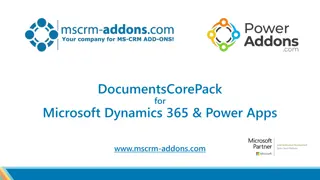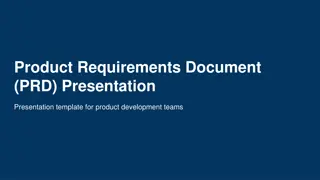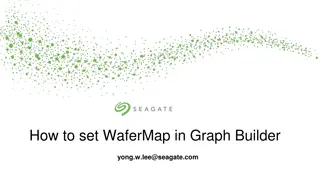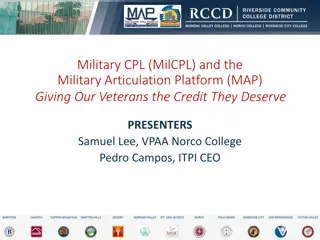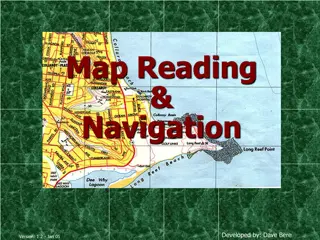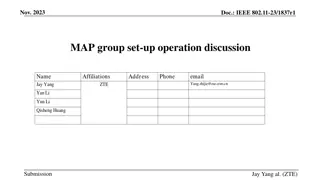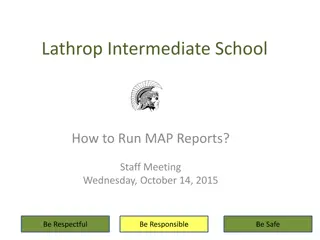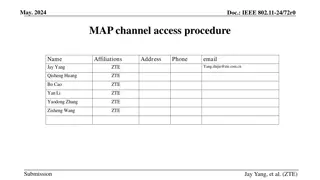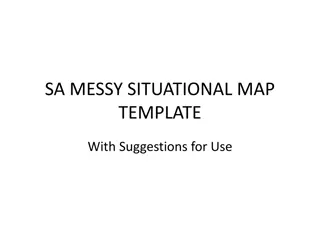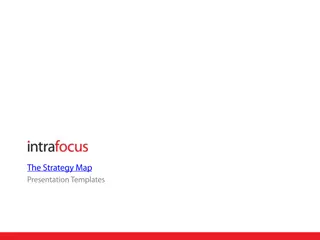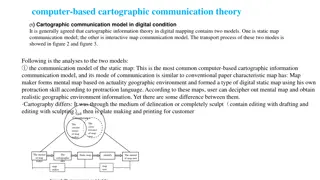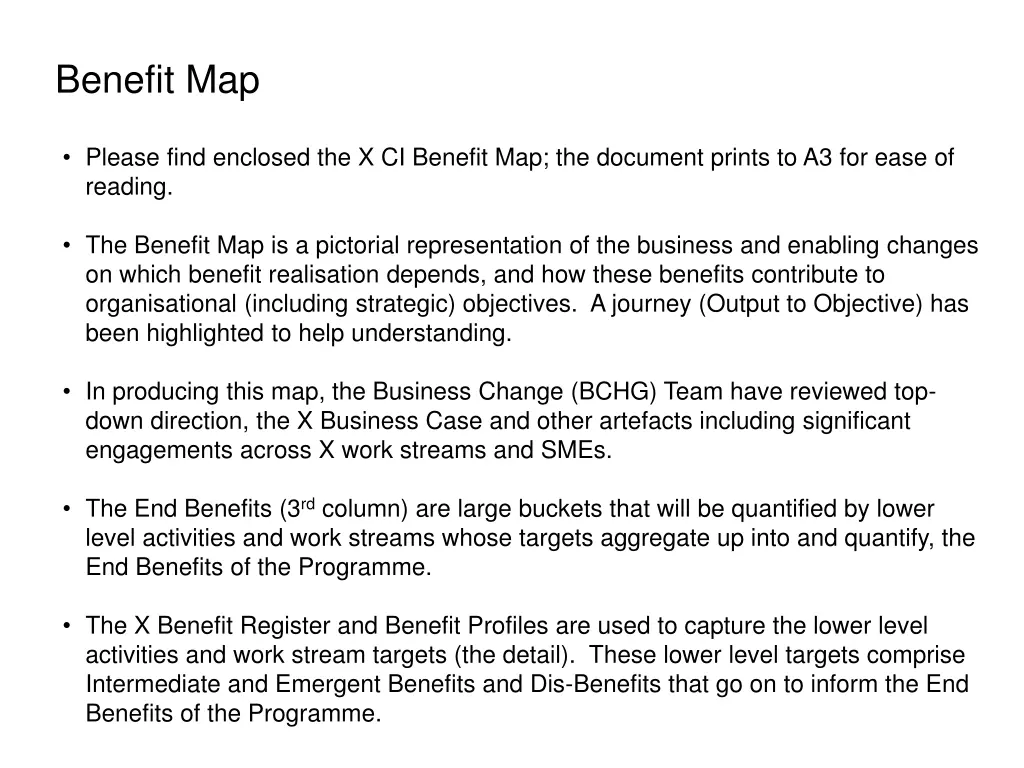
X CI Benefit Realisation Mapping for Organisational Objectives
Explore the detailed X CI Benefit Map showcasing business changes and enabling factors crucial for benefit realisation aligned with organizational objectives and strategies. The visual journey highlights outputs linked to objectives, emphasizing the significance of lower-level activities and work streams in quantifying end benefits of the programme.
Download Presentation

Please find below an Image/Link to download the presentation.
The content on the website is provided AS IS for your information and personal use only. It may not be sold, licensed, or shared on other websites without obtaining consent from the author. If you encounter any issues during the download, it is possible that the publisher has removed the file from their server.
You are allowed to download the files provided on this website for personal or commercial use, subject to the condition that they are used lawfully. All files are the property of their respective owners.
The content on the website is provided AS IS for your information and personal use only. It may not be sold, licensed, or shared on other websites without obtaining consent from the author.
E N D
Presentation Transcript
Benefit Map Please find enclosed the X CI Benefit Map; the document prints to A3 for ease of reading. The Benefit Map is a pictorial representation of the business and enabling changes on which benefit realisation depends, and how these benefits contribute to organisational (including strategic) objectives. A journey (Output to Objective) has been highlighted to help understanding. In producing this map, the Business Change (BCHG) Team have reviewed top- down direction, the X Business Case and other artefacts including significant engagements across X work streams and SMEs. The End Benefits (3rd column) are large buckets that will be quantified by lower level activities and work streams whose targets aggregate up into and quantify, the End Benefits of the Programme. The X Benefit Register and Benefit Profiles are used to capture the lower level activities and work stream targets (the detail). These lower level targets comprise Intermediate and Emergent Benefits and Dis-Benefits that go on to inform the End Benefits of the Programme.
Name of Change Initiative - Benefit Map High Level Outputs (Main Thing) Training Outcomes End Benefits Departmental, Portfolio & Wider Objectives Processes: Business Model (Operations/Functions); Performance Levels; Ways of Working. Efficiency EB-01: Time Savings. Context. OP-01: Description. OC-01: Title. Context. DO-1: Description. OP-02: Oracle Guided Learning (OGL) products Primary End Benefits EB-02: Reduced Expenditure/VfM. On premise servers removed; fewer contracts; cost optimisation; fewer licenses; integration; convergence; monetised time savings; value for money; avoidance. Equipment Economic OP-03: Decommission 4 on premises Servers in London DO-2: Description. OP-04: Description. OC-02: Title. Context. EB-03: FTE Savings. Context. OP-05: Description. DO-3: Description. Efficiency Personnel OC-03: Title. Context. OP-06: Description. DO-4: Description. Information EB-04: Greater Integration. Context. OP-07: Description. Organisation: Skills; Staffing levels; Roles; Culture; Training Needs. PO-1: Description. OP-08: Description. OC-04: Title. Context. OP-09: Description. PO-2: Description. OP-10: Description. OC-05: Title. Context. EB-05: More Automation. Context. OP-11: Description. OC-06: Title. Context. PO-3: Description. OP-12: Description. Technology: Systems; Tools; Resources (i.e. Buildings & Infrastructure). OP-13: Description. EB-06: Improved Data Quality. Context. PO-4: Description. OC-07: Systems. The organisation has improved its information capabilities, business continuity, threat mitigation, technological advances, supply and demand and business efficiency. Secondary End Benefits OP-14: Resilient, secure global cloud platform and portal. Effectiveness PO-5: Description. OP-15: Description. OC-08: Title. Context. EB-07: Fewer Burdens (Physical and Cognitive). Context. OP-16: Description. SO-6: Description. OC-09: Title. Context. OP-17: Description. Doctrine & Concepts SO-7: Description. OC-10: Title. Context. OP-18: Description. Organisation SO-8: Living within our means EB-08: Better Access to Information. Context. OP-19: Description. OC-11: Title. Context. OP-20: Description. SO-9: Description. Information: New Data; Data Outcomes; Data for Reporting. Logistics OC-12: Title. Context. OP-21: Description. EB-09: Information Advantage. Context. Interoperability SO-10: Description. OC-13: Title. Context. OP-22: Description.
Name of Change Initiative - Benefit Map Key Outcomes End Benefits Primary Secondary Tertiary Processes: Business Model (Operations/Functions); Performance Levels; Ways of Working. Efficiency EB-01: Time Savings. Context. OC-01: Title. Context. Primary End Benefits EB-02: Reduced Expenditure/VfM. On premise servers removed; fewer contracts; cost optimisation; fewer licenses; integration; convergence; monetised time savings; value for money; avoidance. Economic OC-02: Title. Context. EB-03: FTE Savings. Context. Efficiency OC-03: Title. Context. EB-04: Greater Integration. Context. Organisation: Skills; Staffing levels; Roles; Culture; Training Needs. OC-04: Title. Context. OC-05: Title. Context. EB-05: More Automation. Context. OC-06: Title. Context. Technology: Systems; Tools; Resources (i.e. Buildings & Infrastructure). EB-06: Improved Data Quality. Context. OC-07: Systems. The organisation has improved its information capabilities, business continuity, threat mitigation, technological advances, supply and demand and business efficiency. Secondary End Benefits Effectiveness OC-08: Title. Context. EB-07: Fewer Burdens (Physical and Cognitive). Context. OC-09: Title. Context. OC-10: Title. Context. EB-08: Better Access to Information. Context. OC-11: Title. Context. Information: New Data; Data Outcomes; Data for Reporting. OC-12: Title. Context. EB-09: Information Advantage. Context. OC-13: Title. Context.
Name of Change Initiative - Benefit Map Key Outcomes End Benefits Primary Secondary Tertiary Processes: Business Model (Operations/Functions); Performance Levels; Ways of Working. Efficiency EB-01: Time Savings. Context. OC-01: Title. Context. Primary End Benefits EB-02: Reduced Expenditure/VfM. On premise servers removed; fewer contracts; cost optimisation; fewer licenses; integration; convergence; monetised time savings; value for money; avoidance. Economic OC-02: Title. Context. EB-03: FTE Savings. Context. Efficiency OC-03: Title. Context. EB-04: Greater Integration. Context. Organisation: Skills; Staffing levels; Roles; Culture; Training Needs. OC-04: Title. Context. OC-05: Title. Context. EB-05: More Automation. Context. OC-06: Title. Context. Technology: Systems; Tools; Resources (i.e. Buildings & Infrastructure). EB-06: Improved Data Quality. Context. OC-07: Systems. The organisation has improved its information capabilities, business continuity, threat mitigation, technological advances, supply and demand and business efficiency. Secondary End Benefits Effectiveness OC-08: Title. Context. EB-07: Fewer Burdens (Physical and Cognitive). Context. OC-09: Title. Context. OC-10: Title. Context. EB-08: Better Access to Information. Context. OC-11: Title. Context. Information: New Data; Data Outcomes; Data for Reporting. OC-12: Title. Context. EB-09: Information Advantage. Context. OC-13: Title. Context.
Name of Change Initiative - Benefit Map Key Outcomes End Benefits Primary Secondary Tertiary Processes: Business Model (Operations/Functions); Performance Levels; Ways of Working. Efficiency EB-01: Time Savings. Context. OC-01: Title. Context. Primary End Benefits EB-02: Reduced Expenditure/VfM. On premise servers removed; fewer contracts; cost optimisation; fewer licenses; integration; convergence; monetised time savings; value for money; avoidance. Economic OC-02: Title. Context. EB-03: FTE Savings. Context. Efficiency OC-03: Title. Context. EB-04: Greater Integration. Context. Organisation: Skills; Staffing levels; Roles; Culture; Training Needs. OC-04: Title. Context. OC-05: Title. Context. EB-05: More Automation. Context. OC-06: Title. Context. Technology: Systems; Tools; Resources (i.e. Buildings & Infrastructure). EB-06: Improved Data Quality. Context. OC-07: Systems. The organisation has improved its information capabilities, business continuity, threat mitigation, technological advances, supply and demand and business efficiency. Secondary End Benefits Effectiveness OC-08: Title. Context. EB-07: Fewer Burdens (Physical and Cognitive). Context. OC-09: Title. Context. OC-10: Title. Context. EB-08: Better Access to Information. Context. OC-11: Title. Context. Information: New Data; Data Outcomes; Data for Reporting. OC-12: Title. Context. EB-09: Information Advantage. Context. OC-13: Title. Context.
Name of Change Initiative - Benefit Map Key Outcomes End Benefits Primary Secondary Tertiary Processes: Business Model (Operations/Functions); Performance Levels; Ways of Working. Efficiency EB-01: Time Savings. Context. OC-01: Title. Context. Primary End Benefits EB-02: Reduced Expenditure/VfM. On premise servers removed; fewer contracts; cost optimisation; fewer licenses; integration; convergence; monetised time savings; value for money; avoidance. Economic OC-02: Title. Context. EB-03: FTE Savings. Context. Efficiency OC-03: Title. Context. EB-04: Greater Integration. Context. Organisation: Skills; Staffing levels; Roles; Culture; Training Needs. OC-04: Title. Context. OC-05: Title. Context. EB-05: More Automation. Context. OC-06: Title. Context. Technology: Systems; Tools; Resources (i.e. Buildings & Infrastructure). EB-06: Improved Data Quality. Context. OC-07: Systems. The organisation has improved its information capabilities, business continuity, threat mitigation, technological advances, supply and demand and business efficiency. Secondary End Benefits Effectiveness OC-08: Title. Context. EB-07: Fewer Burdens (Physical and Cognitive). Context. OC-09: Title. Context. OC-10: Title. Context. EB-08: Better Access to Information. Context. OC-11: Title. Context. Information: New Data; Data Outcomes; Data for Reporting. OC-12: Title. Context. EB-09: Information Advantage. Context. OC-13: Title. Context.
Name of Change Initiative - Benefit Map Key Outcomes End Benefits Primary Secondary Tertiary Processes: Business Model (Operations/Functions); Performance Levels; Ways of Working. Efficiency EB-01: Time Savings. Context. OC-01: Title. Context. Primary End Benefits EB-02: Reduced Expenditure/VfM. On premise servers removed; fewer contracts; cost optimisation; fewer licenses; integration; convergence; monetised time savings; value for money; avoidance. Economic OC-02: Title. Context. EB-03: FTE Savings. Context. Efficiency OC-03: Title. Context. EB-04: Greater Integration. Context. Organisation: Skills; Staffing levels; Roles; Culture; Training Needs. OC-04: Title. Context. OC-05: Title. Context. EB-05: More Automation. Context. OC-06: Title. Context. Technology: Systems; Tools; Resources (i.e. Buildings & Infrastructure). EB-06: Improved Data Quality. Context. OC-07: Systems. The organisation has improved its information capabilities, business continuity, threat mitigation, technological advances, supply and demand and business efficiency. Secondary End Benefits Effectiveness OC-08: Title. Context. EB-07: Fewer Burdens (Physical and Cognitive). Context. OC-09: Title. Context. OC-10: Title. Context. EB-08: Better Access to Information. Context. OC-11: Title. Context. Information: New Data; Data Outcomes; Data for Reporting. OC-12: Title. Context. EB-09: Information Advantage. Context. OC-13: Title. Context.

